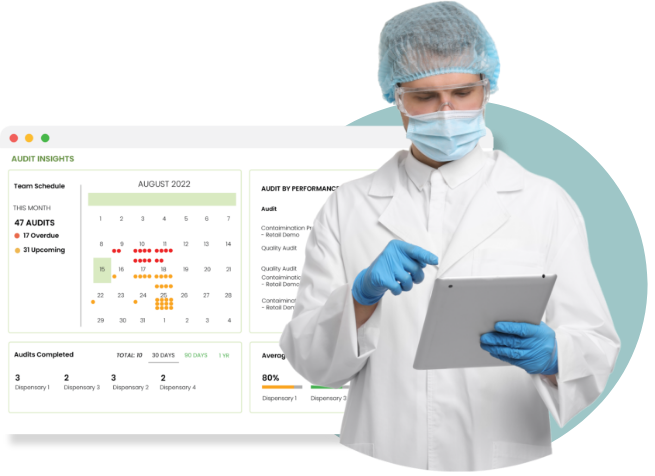Author: Ben Hartman | December 14, 2023 | 6 Min Read
What are the 7 Principles of HACCP?

In the food industry, all types of biological, chemical, and physical hazards pose risks to product safety and the health and well-being of consumers.
For more than five decades, the food safety management system known as Hazard Analysis and Critical Control Points (HACCP) has helped companies in the food industry evaluate, monitor, and eliminate threats to product safety throughout the production process.
But while HACCP guidelines are most known for how they help ensure safety in the food industry, they can also be applied by cannabis companies to create safer consumable products such as edibles and vaping formulations.
What is HACCP?
The U.S. Food and Drug Administration (FDA) describes HACCP as “a management system in which food safety is addressed through the analysis and control of biological, chemical, and physical hazards from raw material production, procurement, and handling, to manufacturing, distribution, and consumption of the finished product.”
The FDA lists several preliminary steps before applying HACCP principles to products and processes. These include assembling a HACCP team, describing the food, its ingredients, processing, and distribution methods, describing the intended use of the food, and developing and verifying a flow diagram of the process of making the product.
The FDA also lists the seven principles on which HACCP is based:
Conduct a Hazard Analysis
The FDA describes the purpose of hazard analysis as “to develop a list of hazards which are of such significance that they are reasonably likely to cause injury or illness if not effectively controlled.”
These include biological hazards like pathogens, chemical risks such as pesticides and industrial chemicals, and physical hazards like choking risks or materials like glass or hard plastic.
According to HACCP expert and consultant Kathy Knutson, Ph.D., hazard analysis is the critical first step in any implementation plan.
“Hazard Analysis is a big deal. It is where everything begins because you can’t do any of those steps until you've done a great job on your hazard analysis.”
Knutson said that she prefers to do hazard analysis as two separate steps. These are first, to document every ingredient a facility receives, and second, to determine and document all of the process steps.
“From the hazard analysis, a facility can determine what its critical control points are going to be. And those are the steps where hazards are controlled.”
To illustrate the importance of hazard analysis, Knutson said it is something that can by no means be rushed.
“However long you think it’s going to take to do an analysis of a facility, multiply that by something like 10 or 20 or 30. It’s going to take a lot longer than you think.”
Determine the Critical Control Points
According to the U.S. Department of Agriculture (USDA), a critical control point is “a step in a food production process at which a control can be applied to prevent, eliminate, or reduce a food safety hazard at acceptable levels.”
For food pathogens, these can include steps such as cooking, stabilization, drying, fermentation, pasteurization, and acid rinses, among others.
Knutson said that determining what these critical control points (CCP) are is done by carrying out a risk assessment. In the risk assessment, the [HACCP] team will identify if there are any biological, chemical, or physical hazards and then take those identified hazards and use a risk matrix as a tool to determine the likelihood of an illness or injury.
“Using the risk matrix, we divide and conquer and determine where to put our resources for critical control points.”
Establish critical limits
How do you know that a product - be it a food product or a cannabis edible - is safe? It requires knowing the necessary values for product safety, which are known as critical limits.
The USDA defines critical limits as “the maximum or minimum value to which a process must be controlled at a CCP to prevent, eliminate, or reduce the hazard to an acceptable level.”
Some of the parameters for critical limits include temperature, moisture level, time, and water activity. For cannabis edibles, for instance, these limits can include the temperature at the “kill step” needed to eliminate pathogens during production.
Establish monitoring procedures
Throughout production, CCPs must be monitored to validate that they are eliminating the hazards they are designed for. Monitoring procedures are necessary to determine if a critical limit is being met and to ensure that records are being kept for verification.
Some of the tools used for monitoring CCPs include thermometers, timers, and flow rate meters. If the monitoring values don’t meet the critical limits, then those supervising production know that product safety may be compromised and can take actions to mitigate the risk.
According to Knutson, line operators are the best employees to be tasked with monitoring in that they are present directly at the point of production.
Establish Corrective Actions
When deviations from a CCP occur, corrective actions must be initiated and must be identified in the facility’s HACCP plan.
In a production facility, those in charge of corrective actions must record every aspect of the deviation, the impact on the product, the cause of the investigation, and the steps needed to ensure it doesn’t happen again. They must also ensure that any unsafe products are removed from the production line.
“The people who actually carry out the best practices are the people right there on the line. So the line operators need to be trained in what to do if there's a deviation,” Knutson said.
Establish verification procedures
Verification procedures involve “proving that what was decided by the food safety team is actually implemented and consistently done.”
According to the FDA, verification “is defined as those activities, other than monitoring, that determine the validity of the HACCP plan and that the system is operating according to the plan.”
Putting these verification procedures in place and following them is essential to making sure that the HACCP plan is suitable for controlling identified hazards and that it is being followed correctly.
Establish record-keeping and documentation procedures
Food and cannabis production facilities must maintain a recordkeeping system that includes written documentation of how the HACCP plan operates and records that validate the actions taken.
This includes a breakdown of the hazard analysis, the HACCP plan, and who is responsible for which steps, critical limits, corrective actions, critical control points, and the monitoring performed.
Knutson stated that a supervisor or manager should be responsible for reviewing, signing, verifying, and dating records.
How important is HACCP training?
Knutson said that she believes that everyone on a facility’s HACCP team should receive training on the seven principles and that supervising all of this work requires a trained HACCP coordinator.
“Either some in-house training has to occur, or people have to go to dedicated HACCP training to really understand it,” Knutson said.
She also said that every team in the facility - such as maintenance, sanitation, or operations - should have a member who takes part in the HACCP training.
“Each member brings their own perspective and expertise on food safety and they all really need to be trained.”
The need for expert, professional HACCP guidance is crucial, especially considering how complicated the guidelines can be.
Describing her journey with HACCP, Knutson said it was to some extent a mystery at first, but focus and effort cleared a path forward.
“When you first approach [HACCP], it seems really overwhelming. It's kind of like doing a puzzle. You have to be laser-focused and do it piece by piece by piece.”
Rootwurks is set to launch our HACCP certification course. At only $99, it is the most affordable certification course recognized by the International HACCP Alliance. To get more details and to make sure we let you know the second the course is available, join our waiting list here:
Contributors

Ben Hartman
From HACCP certification to the basics of hygiene, our on-demand courseware has you covered.






.jpg?width=120&height=80&name=Baby%20(1).jpg)

